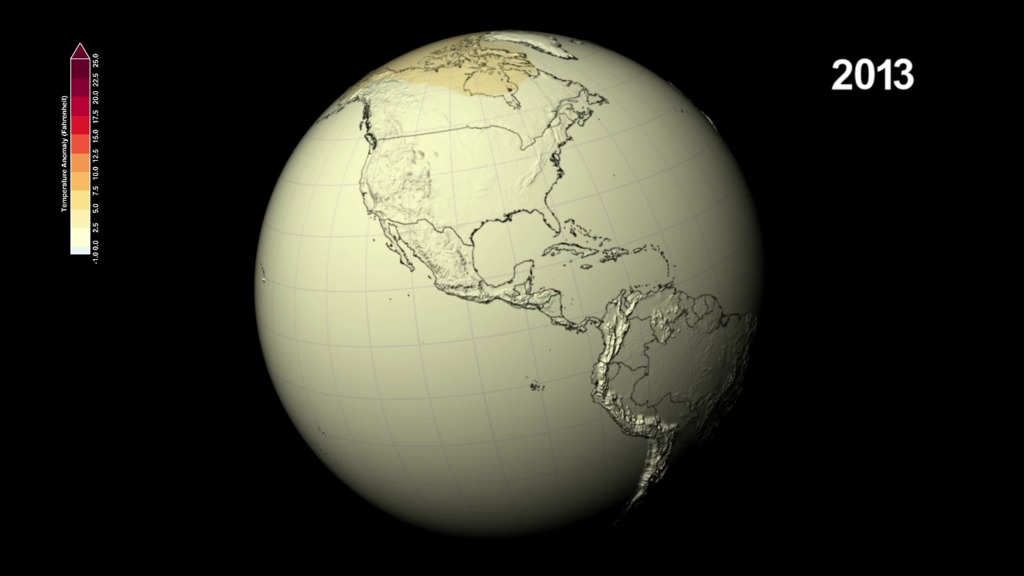CMIP5: 21st Century Temperature Scenarios
These data visualizations from the NASA Center for Climate Simulation and NASA's Scientific Visualization Studio at Goddard Space Flight Center, Greenbelt, Md., show how climate models used in the new report from the United Nations' Intergovernmental Panel on Climate Change (IPCC) estimate possible temperature pattern changes throughout the 21st century.
The United Nations' Intergovernmental Panel on Climate Change publishes a report on the consensus view of climate change science about every five to seven years. The first findings of the IPCC's Fifth Assessment Report (AR5) were released on Sept. 27, 2013, in the form of the Summary for Policymakers report and a draft of IPCC Working Group 1's Physical Science Basis. The IPCC does not perform new science but instead authors a report that establishes the established understanding of the world's climate science community.
The report not only includes observations of the real world but also the results of climate model projections of how the Earth will respond as a system to rising greenhouse gas concentrations in the atmosphere. The IPCC's AR5 relies on the Coupled Model Intercomparison Project Phase 5 (CMIP5) effort, an international effort among the climate modeling community to coordinate climate change experiments.
These visualizations represent the mean output of how of how certain groups of CMIP5 models responded to four different scenarios defined by the IPCC called Representative Concentration Pathways (RCPs). These four RCPs – 2.6, 4.5, 6 and 8.5 – represent a wide range of potential worldwide greenhouse gas emissions and sequestration scenarios for the coming century. The pathways are numbered based on the expected Watts per square meter – essentially a measure of how much heat energy is being trapped by the climate system – each scenario would produce. The pathways are partly based on the ultimate concentrations of carbon dioxide and other greenhouse gases. The current carbon dioxide concentration in the atmosphere is around 400 parts per million, up from less than 300 parts per million at the end of the 19th century.
The carbon dioxide concentrations in the year 2100 for each RCP are:
RCP 2.6: 421 ppm
RCP 4.5: 538 ppm
RCP 6: 670 ppm
RCP 8.5: 936 ppm
Each visualization represents the mean output of a different number of models for each RCP, because data from all models in the CMIP5 project was not available in the same format for visualization for each RCP. All of the models compare a projection of temperatures from 2006-2099 to a baseline historical average from 1971-2000.
Thus, the values shown for each year represent the departure for that year compared to the observed average global surface temperature from 1971-2000. The IPCC report used 1986-2005 as a baseline period, making its reported anomalies slightly different from those shown in the visualizations.
Animation of RCP 8.5 without dates.
Animation of RCP 6.0 without dates.
Animation of RCP 4.5 without dates.
Animation of RCP 2.6 without dates.

Colorbar for IPCC temperature anomalies ranging from -1.0 to 25.0 degrees Fahrenheit.
Correlated year overlay for each of the above animations.
Composite sequence of ensemble RCP 8.5 with date overlay and legend composited.
Credits
Please give credit for this item to:
NASA's Goddard Space Flight Center Scientific Visualization Studio
Additional credits should also go to the IPCC community, without whom these visualizations would not have been possible. Please click here for all the IPCC contributors.
-
Animators
- Alex Kekesi (Global Science and Technology, Inc.)
- Greg Shirah (NASA/GSFC)
- Lori Perkins (NASA/GSFC)
-
Producer
- Matthew R. Radcliff (USRA)
-
Scientists
- Gerald Potter (USRA)
- Laura Carriere (CSC)
- Jay Alder (USGS)
- Ellen Salmon (NASA/GSFC)
- Michael Wehner (Lawrence Berkeley National Laboratory)
- Dean Williams (Lawrence Livermore National Laboratory)
-
Project support
- Jarrett Cohen (Global Science and Technology, Inc.)
-
Writer
- Patrick Lynch (Wyle Information Systems)
Release date
This page was originally published on Friday, September 27, 2013.
This page was last updated on Thursday, June 27, 2024 at 11:02 AM EDT.
Datasets used in this visualization
-
CMIP5 (Coupled Model Intercomparison Project Phase 5)
ID: 797
Note: While we identify the data sets used in these visualizations, we do not store any further details, nor the data sets themselves on our site.

